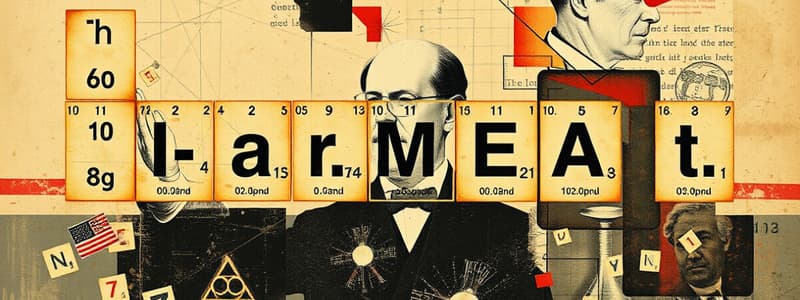Podcast
Questions and Answers
In the modern periodic table, how are elements ordered?
In the modern periodic table, how are elements ordered?
according to increasing atomic number
What similarity in chemical properties did Mendeleev notice?
What similarity in chemical properties did Mendeleev notice?
certain similarities appeared at regular intervals when arranged by atomic mass
What does the modern periodic law state?
What does the modern periodic law state?
the physical and chemical properties of an element are functions of its atomic number
How did the discovery of noble gases change Mendeleev's periodic table?
How did the discovery of noble gases change Mendeleev's periodic table?
What is the most distinctive property of the noble gases?
What is the most distinctive property of the noble gases?
What is the most reactive group in the periodic table?
What is the most reactive group in the periodic table?
What is the atomic number of the second element in group 1?
What is the atomic number of the second element in group 1?
What is a group in the periodic table?
What is a group in the periodic table?
What is a period in the periodic table?
What is a period in the periodic table?
Explain the distinction between atomic mass and atomic number.
Explain the distinction between atomic mass and atomic number.
Give the group numbers for each of the following blocks: s block, p block, d block.
Give the group numbers for each of the following blocks: s block, p block, d block.
What happens to energy when an electron is added to a neutral atom?
What happens to energy when an electron is added to a neutral atom?
What is the term for the energy required to remove an electron from an atom?
What is the term for the energy required to remove an electron from an atom?
Do electron affinity values generally increase or decrease?
Do electron affinity values generally increase or decrease?
Do ionization energy values generally increase or decrease?
Do ionization energy values generally increase or decrease?
Do atomic radii tend to become larger or smaller?
Do atomic radii tend to become larger or smaller?
Name the halogen with the least electron affinity.
Name the halogen with the least electron affinity.
Which alkali metal has the highest ionization energy?
Which alkali metal has the highest ionization energy?
Name the element in period 3 with the smallest atomic radius.
Name the element in period 3 with the smallest atomic radius.
Which group 14 element has the largest electronegativity?
Which group 14 element has the largest electronegativity?
Compare the radius of a positive ion to the radius of its neutral atom.
Compare the radius of a positive ion to the radius of its neutral atom.
Compare the radius of a negative ion to the radius of its neutral atom.
Compare the radius of a negative ion to the radius of its neutral atom.
Study Notes
Periodic Table Fundamentals
- Modern periodic table organizes elements by increasing atomic number.
- Mendeleev's original arrangement utilized atomic mass, revealing periodic similarities in chemical properties.
Modern Periodic Law
- States that physical and chemical properties depend on an element's atomic number.
- The introduction of noble gases created a new group in the periodic table.
Noble Gases and Reactivity
- Noble gases are characterized by their largely unreactive nature.
- The most reactive group in the periodic table is the alkali metals.
Atomic Structure
- Lithium (Li), in group 1, has an atomic number of 3; the second element, sodium (Na), has an atomic number of 11.
- Atomic number is defined by the number of protons, while atomic mass includes both protons and neutrons.
Periods and Groups
- The periodic table consists of vertical columns (groups) and horizontal rows (periods).
- Group numbers for blocks:
- s block: Groups 1-2
- p block: Groups 13-18
- d block: Groups 3-12
Electron Behavior and Energies
- Adding an electron to a neutral atom can absorb or release energy.
- The energy needed to remove an electron is the atom's ionization energy.
Trends in Elements
- Electron affinity values tend to increase across a period.
- Ionization energy values also tend to increase from left to right.
- Atomic radii generally become smaller as you move across a period.
Specific Element Properties
- The halogen with the least electron affinity is Astatine (At).
- Lithium (Li) has the highest ionization energy among alkali metals.
- The element in period 3 with the smallest atomic radius is Argon (Ar).
- Carbon (C) has the largest electronegativity in group 14.
Ion Types and Their Sizes
- A positive ion (e.g., Na⁺) is smaller than its neutral counterpart (Na).
- A negative ion (e.g., O²⁻) is larger than its neutral atom.
Studying That Suits You
Use AI to generate personalized quizzes and flashcards to suit your learning preferences.
Description
Test your knowledge on the Periodic Law in Chemistry with this review of Chapter 5. This quiz covers key concepts, such as the arrangement of elements by atomic number and the observations of Mendeleev. Perfect for reinforcing your understanding of the periodic table's structure.




